AMD Phenom II X4 980 Black Edition Review
by Anand Lal Shimpi on May 2, 2011 10:42 PM ESTGaming Performance
In testing Left 4 Dead we use a custom recorded timedemo. We run on a GeForce GTX 280 at 1680 x 1050 with all quality options set to high. No AA/AF enabled.
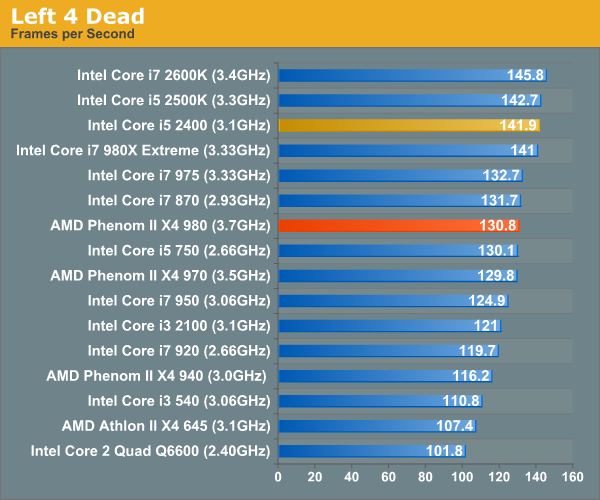
Far Cry 2 ships with several built in benchmarks. For this test we use the Playback (Action) demo at 1680 x 1050 in DX9 mode on a GTX 280. The game is set to medium defaults with performance options set to high.
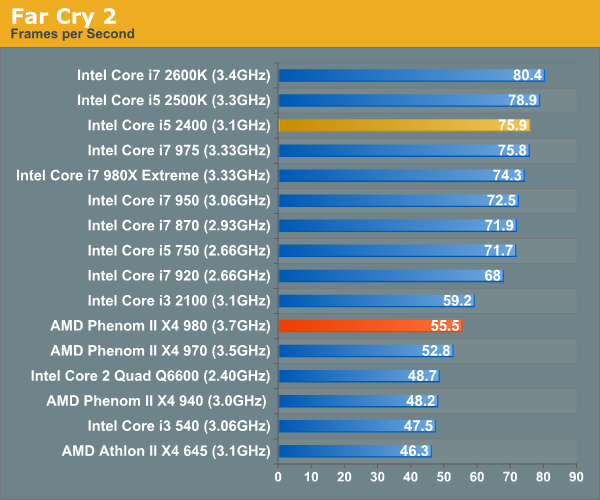
Crysis Warhead also ships with a number of built in benchmarks. Running on a GTX 280 at 1680 x 1050 we run the ambush timedemo with mainstream quality settings. Physics is set to enthusiast however to further stress the CPU.
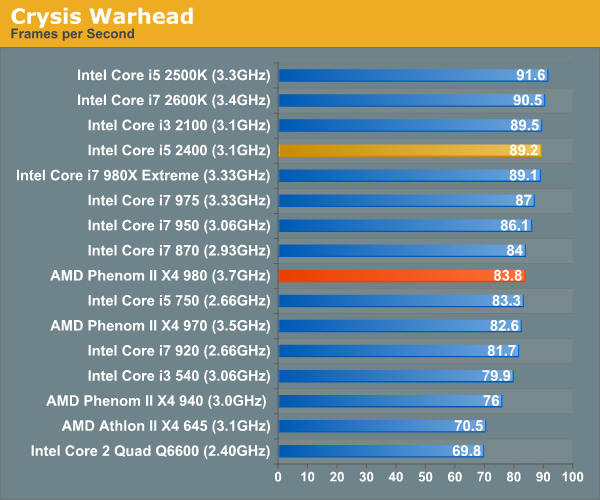
Our Dragon Age: Origins benchmark begins with a shift to the Radeon HD 5870. From this point on these games are run under our Bench refresh testbed under Windows 7 x64. Our benchmark here is the same thing we ran in our integrated graphics tests - a quick FRAPS walkthrough inside a castle. The game is run at 1680 x 1050 at high quality and texture options.
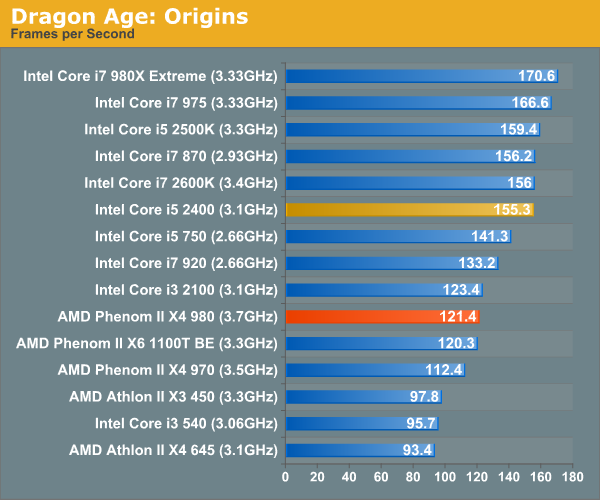
We're running Dawn of War II's internal benchmark at high quality defaults. Our GPU of choice is a Radeon HD 5870 running at 1680 x 1050.
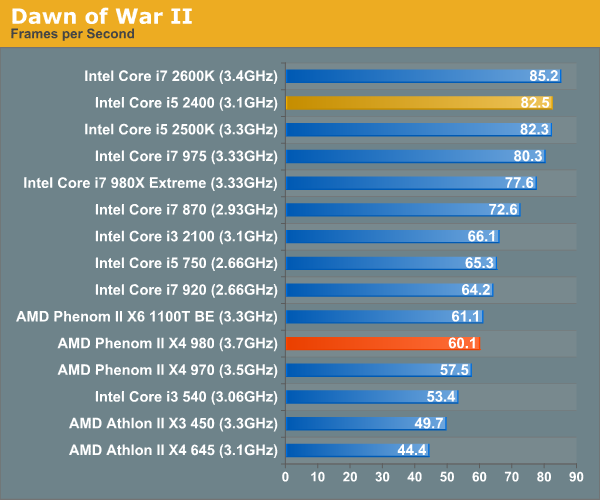
Our World of Warcraft benchmark is a manual FRAPS runthrough of a lightly populated server with no other player controlled characters around. The frame rates here are higher than you'd see in a real world scenario, but the relative comparison between CPUs is accurate.
We run on a Radeon HD 5870 at 1680 x 1050. We're using WoW's high quality defaults but with weather intensity turned down all the way.
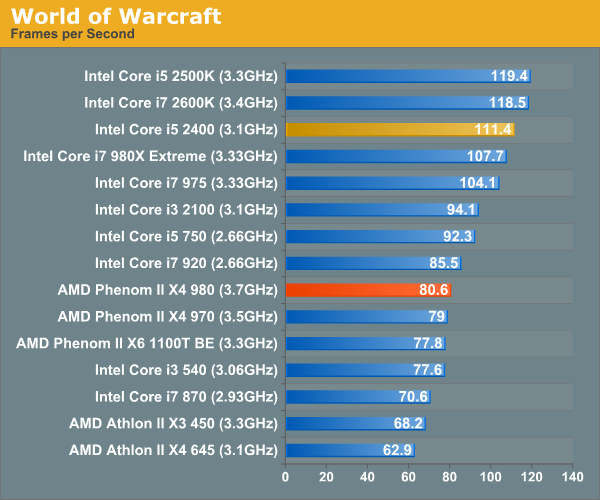
For Starcraft II we're using our heavy CPU test. This is a playback of a 3v3 match where all players gather in the middle of the map for one large, unit-heavy battle. While GPU plays a role here, we're mostly CPU bound. The Radeon HD 5870 is running at 1024 x 768 at medium quality settings to make this an even more pure CPU benchmark.

This is Civ V's built in Late GameView benchmark, the newest addition to our gaming test suite. The benchmark outputs three scores: a full render score, a no-shadow render score and a no-render score. We present the first and the last, acting as a GPU and CPU benchmark respectively.
We're running at 1680 x 1050 with all quality settings set to high. For this test we're using a brand new testbed with 8GB of memory and a GeForce GTX 580.
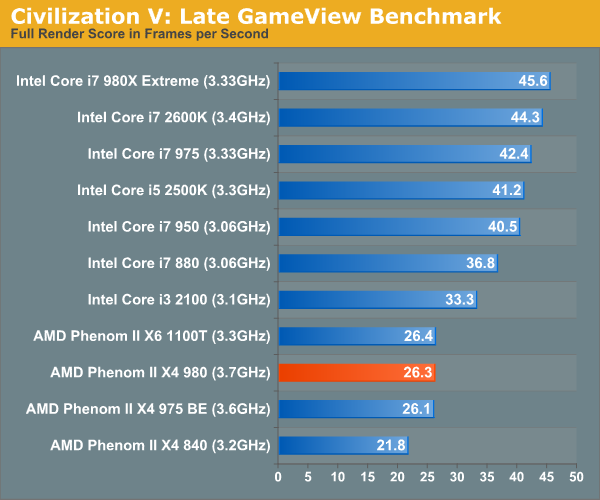
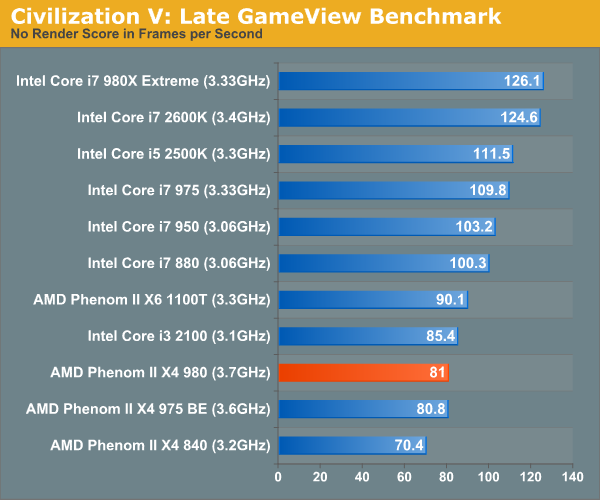










78 Comments
View All Comments
JKflipflop98 - Tuesday, May 3, 2011 - link
ARM gets CRUSHED on the desktop by x86.JimmiG - Tuesday, May 3, 2011 - link
The Q6600 didn't come at 3.7 GHz or overclock to 4.2 with stock cooling. Performance clock for clock doesn't really mean anything.But I'm not disagreeing that the Phenom II is unimpressive. The Phenom II is essentially the same as the Phenom released in 2007, but with more L3 cache. The Phenom itself wasn't all that different from the K8 from 2003, which in itself was just an evolution of the original Athlon.
You could trace current Intel CPUs back to the Pentium Pro in the same way, but they have gone through many more, radical changes over the years. Hopefully those radical changes will come to AMD's CPU architecture with the release of BD.
jabber - Tuesday, May 3, 2011 - link
Look at it another way and you could say AMD have done an amazing job keeping whats essentialy an 8 year old design in the running.When you look at it that way Intel's latest gen chips giving you an extra 10fps isnt that amazing.
BSMonitor - Tuesday, May 3, 2011 - link
"When you look at it that way Intel's latest gen chips giving you an extra 10fps isnt that amazing."FPS are the best case scenario for older/weaker processors as they are ultimately limited by GPU performance....
"Look at it another way and you could say AMD have done an amazing job keeping whats essentialy an 8 year old design in the running."
The Core i series can be trace it's origins to the original Core Duo processors that debuted Apple's transition to x86 (5 Years ago) Intel has had 4 extremely impressive architecture changes since, each improving performance from ~20% to ~100% in some cases... AMD has executed 2. The first Phenom was a HUGE disappointment and couldn't compete with Core 2 Duo's let alone Core 2 Quads.. Phenom II, now gaining traction, is still barely competing against those same Core 2 Quads..
Your same ~10fps difference could be said of my old Core 2 E6600 against your Phenom II x6 in GPU limited scenarios...
AMD's entire success in surpassing Intel was placing the MCU on the CPU die. With that move, they blew their load. Thanks to the power hungry beast that was the netburst processors, Intel worked on improving caching algorithms, multi-threading, parallel processing, etc The end result is Intel with an extremely efficient CPU(born from it's mistakes) and an integrated MCU, AMD is left with just a so-so CPU and an integrated MCU.
Action_Parsnip - Tuesday, May 3, 2011 - link
"FPS are the best case scenario for older/weaker processors as they are ultimately limited by GPU performance...."This sentence has no meaning.
"Intel has had 4 extremely impressive architecture changes since"
I count 3 changes. core 2 -> nehalem wasn't #extremely# impressive, just impressive.
"AMD's entire success in surpassing Intel was placing the MCU on the CPU die."
Your a fool and do not know what your talking about.
MilwaukeeMike - Tuesday, May 3, 2011 - link
"Your a fool and do not know what your talking about. "It's you're btw. "Better to remain silent and let others think you're a fool than open your mouth and remove all doubt" ;)
SlyNine1 - Tuesday, May 3, 2011 - link
""FPS are the best case scenario for older/weaker processors as they are ultimately limited by GPU performance...."This sentence has no meaning."
Made perfect sense to me. The rendering of FPS ( Frames per Second) is a best case senario for older/weaker processors as the bottleneck is elsewhere..
I don't understand how that doesn't make sense, it makes perfect sense.
And getting on someone for saying extremely impressive instead of just impressive, Facepalm!!
Action_Parsnip - Tuesday, May 3, 2011 - link
""FPS are the best case scenario for older/weaker processors as they are ultimately limited by GPU performance...."so is he saying the game tests in this review do not show the same trends as the other tests? That is what he is saying in effect. They look perfectly in line with expectations afaik. The sentence on it's own does mean very little if anything. He is either saying this review is doing something wrong or that gaming tests are of little/no worth.
"nd getting on someone for saying extremely impressive instead of just impressive, Facepalm!!"
ZOMGWTFBBQ111!!!!!!! LOL!!!11
Being a native english speaker, I know there is a difference between impressive and extremely impressive.
Skipping a stone on a lake 20 times is impressive. Walking on the water there is extremely impressive.
extide - Wednesday, May 4, 2011 - link
"Thanks to the power hungry beast that was the netburst processors, Intel worked on improving caching algorithms, multi-threading, parallel processing, etc The end result is Intel with an extremely efficient CPU(born from it's mistakes) and an integrated MCU, AMD is left with just a so-so CPU and an integrated MCU. "I have said this exact same thing many times before. At this point in time making the P4 helped Intel because they had to optimize the heck out of EVERYTHING in it to even be remotely competitive, and well, now all that work is done.
Ushio01 - Tuesday, May 3, 2011 - link
Actually with core/thread/clock being equal 65nm Core2 will beat Phenom II in nearly all benchmarks 45nm Core2 crushes it.